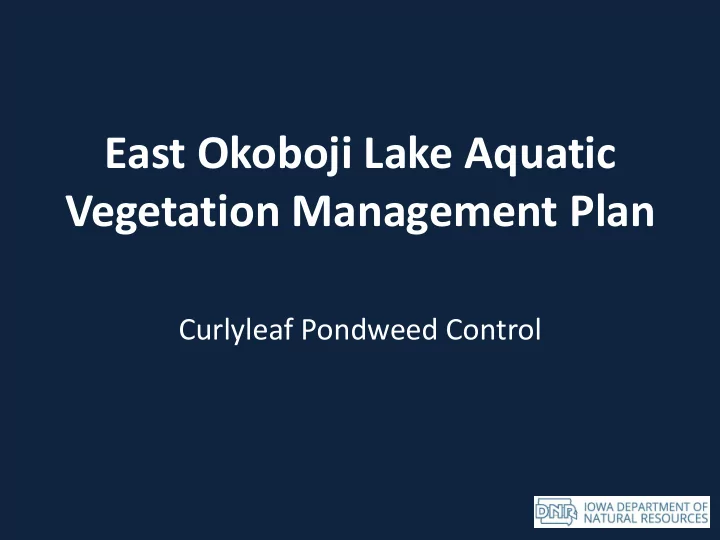

East Okoboji Lake Aquatic Vegetation Management Plan Curlyleaf Pondweed Control
What is Curlyleaf Pondweed? • Non-native submersed, rooted aquatic plant • Introduced in the mid 1800’s • First found in Iowa in 1944, IGL’s in the 1950’s • Widespread - occurring in 48 states • Adapted to cool water • Germinates in the fall and begins growth under ice • Dies back (senecense) in late June to early July • Rapid release of nutrients can cause other issues
Curlyleaf Pondweed ( Potamogeton crispus )
2015 Curlyleaf Growth • Last high growth years were in late 80’s • Regional event in 2015 • Curlyleaf was present all over the IGL’s • Approximately 600 acres – Narrows to north • Navigation and access issues • Future growth is highly unpredictable
Factors influencing growth • Ice duration One of the shortest on record • Snow cover Little snow cover • Turion density Moderate turion density • Water levels Low water levels – 2 years
Aquatic Plant Management Plan • Community led with DNR guidance • Identifies the problem • Affirms the importance of aquatic plants – Balance aquatic habitat with lake use • Identifies options and a course of action • Identifies funding partners and lead entities – Contracting services – Permitting
Importance of Aquatic Plants • Provide habitat for fish and wildlife • Help to stabilize bottom sediments and keep the lakes clear • Absorb wind and wave energy • Act as baffles to settle out sediments • Utilize nutrients otherwise used by algae or cyanobacteria • High diversity of plants is a sign of a health lake
Curlyleaf Pondweed Control and Challenges • Iowa and other states have invested in curlyleaf control and eradication research – Whole lake herbicide treatments – Spot treatments to control nuisance areas – Mechanical cutting • Some success at diminishing turion levels with regular whole lake herbicide treatments – Very expensive – Other consequences
Curlyleaf Pondweed Control and Challenges • Mechanical cutting or raking – 3 to 4 inches of growth per day – Regular cutting over small areas is best – Allowed by law for riparian landowners with docks – Disposal of plants can be problematic • Herbicide treatments – Whole lake or large bay treatments are expensive – Early season low-dose applications are effective and target only curlyleaf pondweed – Pesticide concerns / public perception – Pesticide application by private citizens to public waters is not allowed – Pesticide treatments are needed yearly if curlyleaf persists
2016 Proposal • Riparian landowners can mechanically remove plants (IAC 571, Chapter 54) • Early season low-dose endothall application – Water temps between 50 and 60 degrees • 100 ft wide travel lane, 50 – 100 ft from shore – Provides travel lanes for boats to move south – Minimizes treatment area (cost savings) – Approximately 65 acres of treatment – Commercial application costs - $250-350/acre
Endothall (dipotassium salt of endothall) • Common brand names are Hydrothol or Aquathol K • 600 ft buffer around drinking water intakes • Waters may be used for swimming, fishing, and irrigation immediately after treatment • Several studies show no adverse impacts to fish or other aquatic organisms • Half life is 5 days
Funding • DNR/State – Aquatic Invasive Species Program • Boat registration funds – Lake Restoration Program • Legislative appropriation – Fish and Game Trust Fund • Hunters and anglers – Marine Fuel Tax • 0.9% of motor fuel tax • Local Funds • Over 240 private docks
Blackhawk Lake • Lake access - 62 acre treatment for 2016 • Commercial applicator using endothall – Approximately $19,000 ($306 / acre) – Responsible for permitting and label requirements • Funding – City of Lakeview - $10,000 and contracting – Lake protective association - $3,000 – Sac County - $6,000 • Vegetation harvester - $15,000/year – $5,000 per partner • Iowa DNR – Active lake restoration project with several hundred thousand dollars invested in watershed and in-lake management efforts
Steps forward • Identification and commitment from partners • Finalize the management plan and set investment level (# of acres to be treated) • Initiate contracting and permitting • Application of herbicide in mid to late April
Recommend
More recommend